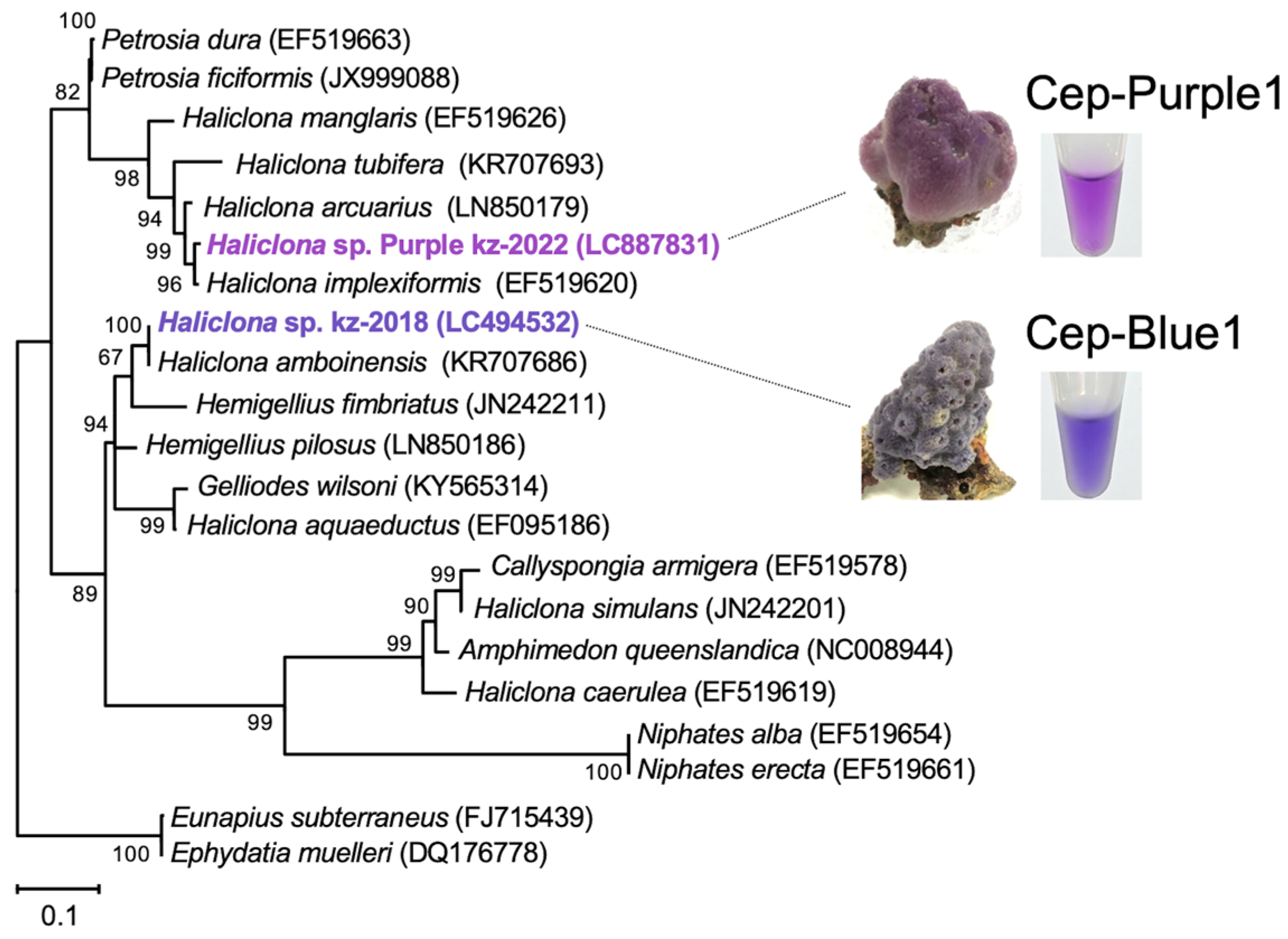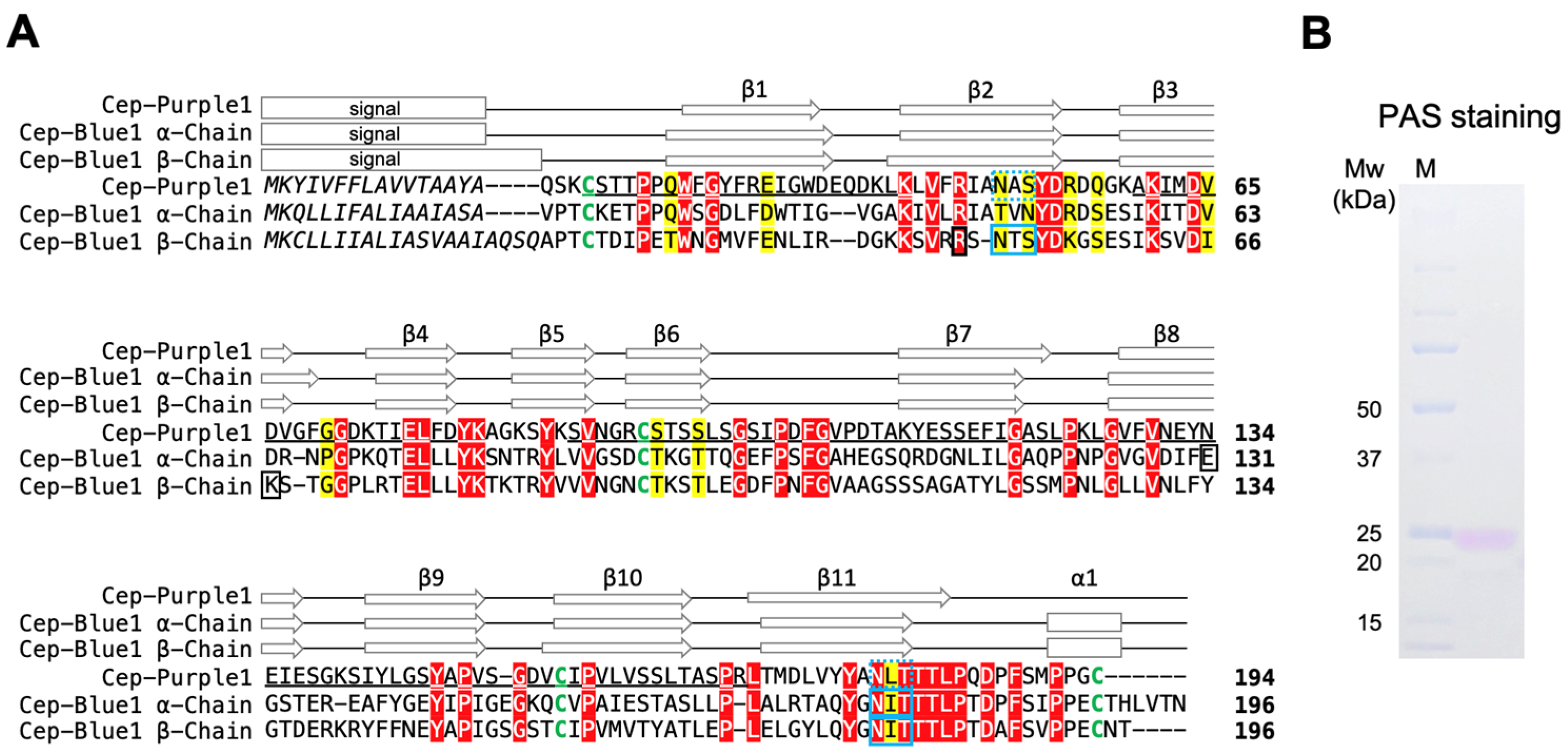An Astaxanthin-Binding Ependymin-Related Purple Protein Responsible for the Coloration of a Marine Purple Sponge, Haliclona sp.
Abstract
1. Introduction
2. Results
2.1. Characterization of Sponge Samples
2.2. Purification and Determination of Protein and Pigments
2.3. Primary Structure of the Purple Protein
2.4. Reconstitution Assays of Carotenoependymin Proteins
3. Discussion
4. Materials and Methods
4.1. Animal Materials and Sponge Characterization
4.2. Purification and Characterization of the Purified Purple Protein
4.3. cDNA Library Construction, Cloning, and Primary Structure Determination of Cep-Purple1
4.4. Extraction and Identification of Carotenoids
4.5. Preparation of Apoprotein and Its Reconstitution with Carotenoids
4.6. Bioinformatics
Supplementary Materials
Author Contributions
Funding
Institutional Review Board Statement
Data Availability Statement
Acknowledgments
Conflicts of Interest
Abbreviations
| EPD | Ependymin |
| EPD-BCP1 | EPD-related blue carotenoprotein-1 |
| Cep-Purple1 | Carotenoependymin-Purple1 |
| AXT | Astaxanthin |
| MXT | Mytiloxanthin |
| COX1 | Cytochrome oxidase c subunit 1 |
| HPLC | High-performance liquid chromatography |
| SDS-PAGE | Sodium dodecyl sulfate-polyacrylamide gel electrophoresis |
References
- Goodwin, T.W. Porifera. In The Biochemistry of the Carotenoids: Animals; Goodwin, T.W., Ed.; Chapman & Hall: London, UK, 1984; Volume 2, pp. 22–34. [Google Scholar]
- Maoka, T. Carotenoids in marine animals. Mar. Drugs 2011, 9, 278–293. [Google Scholar] [CrossRef]
- Furrow, F.B.; Amsler, C.D.; McClintock, J.B.; Baker, B.J. Surface sequestration of chemical feeding deterrents in the Antarctic sponge Latrunculia apicalis as an optimal defense against sea star spongivory. Mar. Biol. 2003, 143, 443–449. [Google Scholar] [CrossRef]
- Elissawy, A.M.; Soleiman Dehkordi, E.; Mehdinezhad, N.; Ashour, M.L.; Pour, P.M. Cytotoxic alkaloids derived from marine sponges: A comprehensive review. Biomolecules 2021, 11, 258. [Google Scholar] [CrossRef]
- Araujo, M.; Xavier, J.R.; Nunes, C.D.; Vaz, P.D.; Humanes, M. Marine sponge melanin: A new source of an old biopolymer. Struct. Chem. 2012, 23, 115–122. [Google Scholar] [CrossRef]
- Vijayan, V.; Jasmin, C.; Anas, A.; Parakkaparambil Kuttan, S.; Vinothkumar, S.; Perunninakulath Subrayan, P.; Nair, S. Sponge-associated bacteria produce non-cytotoxic melanin which protects animal cells from photo-toxicity. Appl. Biochem. Biotechnol. 2017, 183, 396–411. [Google Scholar] [CrossRef] [PubMed]
- Britton, G. Functions of Intact Carotenoids. In Carotenoids: Natural Functions; Britton, G., Liaaen-Jensen, S., Pfander, H., Eds.; Birkhäuser Verlag: Basel, Switzerland, 2008; Volume 4, pp. 189–212. [Google Scholar]
- Maoka, T. Carotenoids as natural functional pigments. J. Nat. Med. 2020, 74, 1–16. [Google Scholar] [CrossRef]
- Liaaen-Jensen, S.; Renstrøm, B.; Ramdahl, T.; Hallenstvet, M.; Bergquist, P. Carotenoids of Marine Sponges. Biochem. Syst. Ecol. 1982, 10, 167–174. [Google Scholar] [CrossRef]
- Liaaen-Jensen, S. Carotenoids in Food Chain. In Carotenoids: Biosynthesis and Metabolism; Britton, G., Liaaen-Jensen, S., Pfander, H., Eds.; Birkhäuser Verlag: Basel, Switzerland, 1998; Volume 3, pp. 359–371. [Google Scholar]
- Kawasaki, S.; Mizuguchi, K.; Sato, M.; Kono, T.; Shimizu, H. A novel astaxanthin-binding photooxidative stress-inducible aqueous carotenoprotein from a eukaryotic microalga isolated from asphalt in midsummer. Plant Cell Physiol. 2013, 54, 1027–1040. [Google Scholar] [CrossRef] [PubMed]
- Kawasaki, S.; Yamazaki, K.; Nishikata, T.; Ishige, T.; Toyoshima, H.; Miyata, A. Photooxidative stress-inducible orange and pink water-soluble astaxanthin-binding proteins in eukaryotic microalga. Commun. Biol. 2020, 3, 490. [Google Scholar] [CrossRef] [PubMed]
- Kawasaki, S.; Kaneko, T.; Asano, T.; Maoka, T.; Takaichi, S.; Shomura, Y. An ependymin-related blue carotenoprotein decorates marine blue sponge. J. Biol. Chem. 2023, 299, 105110. [Google Scholar] [CrossRef]
- Cariello, L.; Zanetti, L. A blue carotenoprotein from the marine sponge Suberites domuncula: Purification and properties. Mar. Biol. 1981, 62, 151–155. [Google Scholar] [CrossRef]
- Czeczuga, B. Investigations of carotenoprotein complexes in animals. XIII. representatives of the porifera. Folia Biol. 1984, 32, 167–174. [Google Scholar]
- Santoro, P.; Guerriero, V.; Parisi, G. An orange carotenoprotein from the marine sponge Axinella verrucosa (O. Schmidt). Purification and properties. Comp. Biochem. Physiol. Part B Biochem. 1990, 97, 645–648. [Google Scholar] [CrossRef]
- Cianci, M.; Rizkallah, P.J.; Olczak, A.; Raftery, J.; Chayen, N.E.; Zagalsky, P.F.; Helliwell, J.R. The molecular basis of the coloration mechanism in lobster shell: β-crustacyanin at 3.2-Å resolution. Proc. Natl. Acad. Sci. USA. 2002, 99, 9795–9800. [Google Scholar] [CrossRef]
- Shashoua, V.E. Ependymin, a brain extracellular glycoprotein, and CNS Plasticity. Ann. N. Y. Acad. Sci. 1991, 627, 94–114. [Google Scholar] [CrossRef]
- Pradel, G.; Schachner, M.; Schmidt, R. Inhibition of memory consolidation by antibodies against cell adhesion molecules after active avoidance conditioning in zebrafish. J. Neurobiol. 1999, 39, 197–206. [Google Scholar] [CrossRef]
- Schmidt, J.T.; Shashoua, V.E. Antibodies to ependymin block the sharpening of the regenerating retinotectal projection in goldfish. Brain Res. 1988, 446, 269–284. [Google Scholar] [CrossRef] [PubMed]
- DeWeerdt, W.H. A monograph of the shallow-water Chalinidae (Porifera, Haplosclerida) of the Caribbean. Beaufortia 2000, 50, 1–67. [Google Scholar]
- De Weerdt, W.H. Family Chalinidae Gray, 1867. In Systema Porifera; Hooper, J.N.A., Van Soest, R.W.M., Willenz, P., Eds.; Springer: New York, NY, USA, 2002; Volume 1, pp. 852–873. [Google Scholar]
- Folmer, O.; Black, M.; Hoeh, W.; Lutz, R.; Vrijenhoek, R. DNA primers for amplification of mitochondrial cytochrome c oxidase subunit I from diverse metazoan invertebrates. Mol. Mar. Biol. Biotechnol. 1994, 3, 294–299. [Google Scholar] [PubMed]
- Erpenbeck, D.; Duran, S.; Rützler, K.; Paul, V.; Hooper, J.N.A.; Wörheide, G. Towards a DNA taxonomy of Caribbean demosponges: A gene tree reconstructed from partial mitochondrial CO1 gene sequences supports previous rDNA phylogenies and provides a new perspective on the systematics of Demospongiae. J. Mar. Biol. Assoc. United Kingd. 2007, 87, 1563–1570. [Google Scholar] [CrossRef]
- Redmond, N.E.; Morrow, C.C.; Thacker, R.W.; Diaz, M.C.; Boury-Esnault, N.; Cárdenas, P.; Hajdu, E.; Lôbo-Hajdu, G.; Picton, B.E.; Pomponi, S.A.; et al. Phylogeny and systematics of demospongiae in light of new small-subunit ribosomal DNA (18S) sequences. Integr. Comp. Biol. 2013, 53, 388–415. [Google Scholar] [CrossRef] [PubMed]
- Vargas, S.; Kelly, M.; Schnabel, K.; Mills, S.; Bowden, D.; Wörheide, G. Diversity in a cold hot-spot: DNA-barcoding reveals patterns of evolution among antarctic demosponges (class demospongiae, phylum Porifera). PLoS ONE 2015, 10, e0127573. [Google Scholar] [CrossRef] [PubMed]
- Redmond, N.E.; van Soest, R.W.M.; Kelly, M.; Raleigh, J.; Travers, S.A.A.; McCormack, G.P. Reassessment of the classification of the Order Haplosclerida (Class Demospongiae, Phylum Porifera) using 18S rRNA gene sequence data. Mol. Phylogenet. Evol. 2007, 43, 344–352. [Google Scholar] [CrossRef]
- Bligh, E.G.; Dyer, W.J. A rapid method of total lipid extraction and purification. Can. J. Biochem. Physiol. 1959, 37, 911–917. [Google Scholar] [CrossRef] [PubMed]
- Srivastava, M.; Simakov, O.; Chapman, J.; Fahey, B.; Gauthier, M.E.A.; Mitros, T.; Richards, G.S.; Conaco, C.; Dacre, M.; Hellsten, U.; et al. The Amphimedon queenslandica genome and the evolution of animal complexity. Nature 2010, 466, 720–726. [Google Scholar] [CrossRef]
- Hooper, J.N.A.; Van Soest, R.W.M. A new species of Amphimedon (Porifera, Demospongiae, Haplosclerida, Niphatidae) from the Capricorn-Bunker Group of Islands, Great Barrier Reef, Australia: Target species for the “sponge genome project”. Zootaxa 2006, 1314, 31–39. [Google Scholar] [CrossRef]
- McDougall, C.; Hammond, M.J.; Dailey, S.C.; Somorjai, I.M.L.; Cummins, S.F.; Degnan, B.M. The evolution of ependymin-related proteins. BMC Evol. Biol. 2018, 18, 182. [Google Scholar] [CrossRef]
- Toyoshima, H.; Miyata, A.; Yoshida, R.; Ishige, T.; Takaichi, S.; Kawasaki, S. Distribution of the water-soluble astaxanthin binding carotenoprotein (Astap) in scenedesmaceae. Mar. Drugs 2021, 19, 349. [Google Scholar] [CrossRef]
- Wybrandt, G.B.; Andersen, S.O. Purification and sequence determination of a yellow protein from sexually mature males of the desert locust, Schistocerca gregaria. Insect Biochem. Mol. Biol. 2001, 31, 1183–1189. [Google Scholar] [CrossRef]
- Sugahara, R.; Tsuchiya, W.; Yamazaki, T.; Tanaka, S.; Shiotsuki, T. Recombinant yellow protein of the takeout family and albino-related takeout protein specifically bind to lutein in the desert locust. Biochem. Biophys. Res. Commun. 2020, 522, 876–880. [Google Scholar] [CrossRef]
- Larkin, M.A.; Blackshields, G.; Brown, N.P.; Chenna, R.; Mcgettigan, P.A.; McWilliam, H.; Valentin, F.; Wallace, I.M.; Wilm, A.; Lopez, R.; et al. Clustal W and clustal X version 2.0. Bioinformatics 2007, 23, 2947–2948. [Google Scholar] [CrossRef]
- Kumar, S.; Stecher, G.; Li, M.; Knyaz, C.; Tamura, K. Mega X: Molecular evolutionary genetics analysis across computing platforms. Mol. Biol. Evol. 2018, 35, 1547–1549. [Google Scholar] [CrossRef]
- Grabherr, M.G.; Haas, B.J.; Yassour, M.; Levin, J.Z.; Thompson, D.A.; Amit, I.; Adiconis, X.; Fan, L.; Raychowdhury, R.; Zeng, Q.; et al. Full-length transcriptome assembly from RNA-Seq data without a reference genome. Nat. Biotechnol. 2011, 29, 644–652. [Google Scholar] [CrossRef] [PubMed]
- Kawasaki, S.; Mitsui, T.; Omori, K.; Tsuboya, T.; Bader, A.; Toyoshima, H.; Takaichi, S. Microalgal AstaP is a natural solubilizer of astaxanthin with broad binding ability for carotenoids and related compounds. Algal Res. 2023, 70, 102982. [Google Scholar] [CrossRef]
- Powell, H.R.; Islam, S.A.; David, A.; Sternberg, M.J.E. Phyre2.2: A community resource for template-based protein structure prediction. J. Mol. Biol. 2025, 437, 168960. [Google Scholar] [CrossRef] [PubMed]





Disclaimer/Publisher’s Note: The statements, opinions and data contained in all publications are solely those of the individual author(s) and contributor(s) and not of MDPI and/or the editor(s). MDPI and/or the editor(s) disclaim responsibility for any injury to people or property resulting from any ideas, methods, instructions or products referred to in the content. |
© 2025 by the authors. Licensee MDPI, Basel, Switzerland. This article is an open access article distributed under the terms and conditions of the Creative Commons Attribution (CC BY) license (https://creativecommons.org/licenses/by/4.0/).
Share and Cite
Kaneko, T.; Asano, T.; Kawasaki, S. An Astaxanthin-Binding Ependymin-Related Purple Protein Responsible for the Coloration of a Marine Purple Sponge, Haliclona sp. Mar. Drugs 2025, 23, 441. https://doi.org/10.3390/md23110441
Kaneko T, Asano T, Kawasaki S. An Astaxanthin-Binding Ependymin-Related Purple Protein Responsible for the Coloration of a Marine Purple Sponge, Haliclona sp. Marine Drugs. 2025; 23(11):441. https://doi.org/10.3390/md23110441
Chicago/Turabian StyleKaneko, Takayuki, Tomomi Asano, and Shinji Kawasaki. 2025. "An Astaxanthin-Binding Ependymin-Related Purple Protein Responsible for the Coloration of a Marine Purple Sponge, Haliclona sp." Marine Drugs 23, no. 11: 441. https://doi.org/10.3390/md23110441
APA StyleKaneko, T., Asano, T., & Kawasaki, S. (2025). An Astaxanthin-Binding Ependymin-Related Purple Protein Responsible for the Coloration of a Marine Purple Sponge, Haliclona sp. Marine Drugs, 23(11), 441. https://doi.org/10.3390/md23110441




